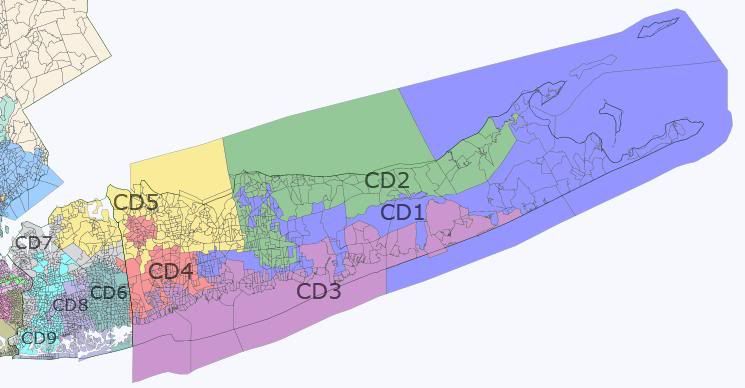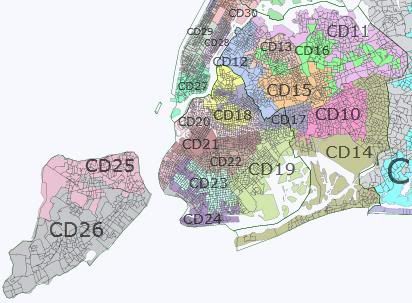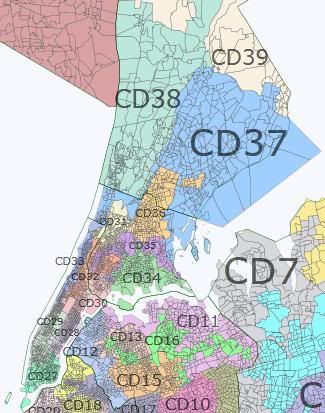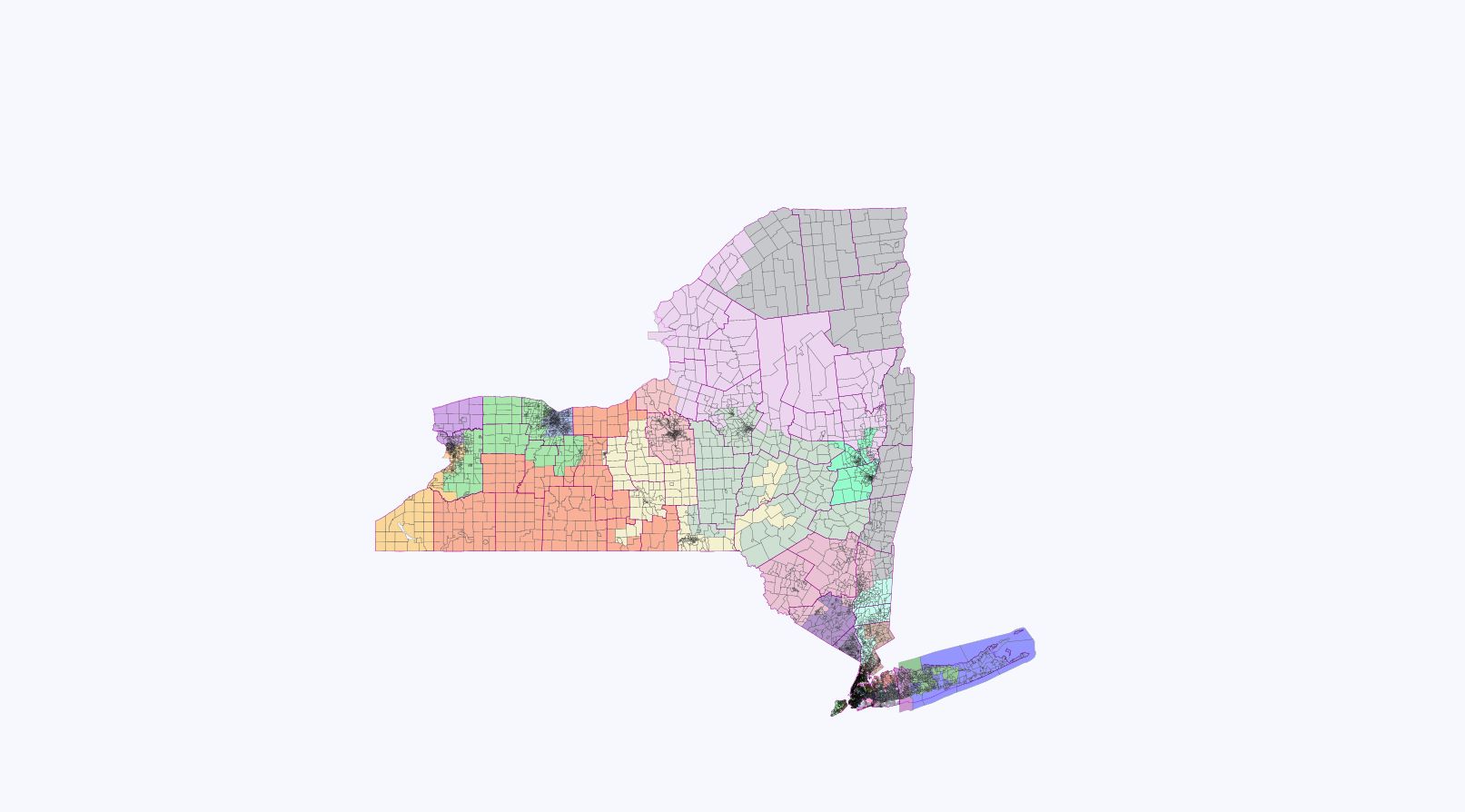
As a thought experiment, I’d figured I try redistricting the state of my birth (and my entire life up to age 30) under the Wyoming Rule discussed elsewhere on this website. Aside from truly applying “one-man, one vote” by ensuring that residents of the smallest state do not have more of a vote than residents of the 3rd largest, there were other benefits of the Wyoming Rule when applied to New York City. I was able under this map to create a new Hispanic VRA-compliant district in Queens (and give Valasquez an entire Brooklyn Hispanic district of her own). In Queens, it was also possible to create an Asian influence “coalition” district that might ensure the election of the first Asian-American congressmember from New York. And through the creation of several Queens/Nassau hybrid districts, I was able probably to ensure Peter King’s removal from public office (a major goal of mine as he is just terrible). In the Bronx, with the smaller sized districts, it is possible not only to create another Hispanic VRA district (sorry Eliot Engel) but also an Black VRA district centered on northern Bronx and neighboring Mount Vernon.
Elsewhere, the major purpose of this map was to maximize Democratic-performing districts, particularly Downstate. I created an open GOP seat in Suffolk County but cracked Peter King’s base and threw him into a 61% Obama district. Staten Island is divided into two and hence neutered as a possible source of Republican votes. In the Hudson Valley, three relatively safe Democratic seats were created with just one district with a Republican PVI (and that seat – Rockland/Orange, a reincarnation of the old Ben Gilman seat – is really more Democratic than the Obama percentages suggest).
Upstate, it is very possible to create a Democratic dummymander (as several of the maps on this site did last year in my opinion). You need to leave some Republican vote sinks. My map does this, aiming for a 7-4 split north of Maurice Hinchey’s now Hudson Valley-centered district. Some of the 4 are within reach for an exceptionally strong Democratic candidate but only one of the 7 Democratic seats is realistically within reach for a Republican now.
This map creates just 6 districts where a Republican has a reasonable shot of winning (the new 2nd out in Suffolk County, the 24th in Rockland/Orange, and 4 districts upstate: the 28th and 29th in Central New York/Adirondacks region, and the 32nd and 34th in Western New York. 29 Democratic seats are at 58% Obama or higher, a 30th Democratic PVI seat (Bill Owen’s new 26th) is at 56% Obama, the best you can draw in that area without splitting Albany which I did not want to do. A 30-6 delegation and not, I believe, a dummymander. But please let me know what you think.
Eastern/Central Long Island (Districts 1-3)
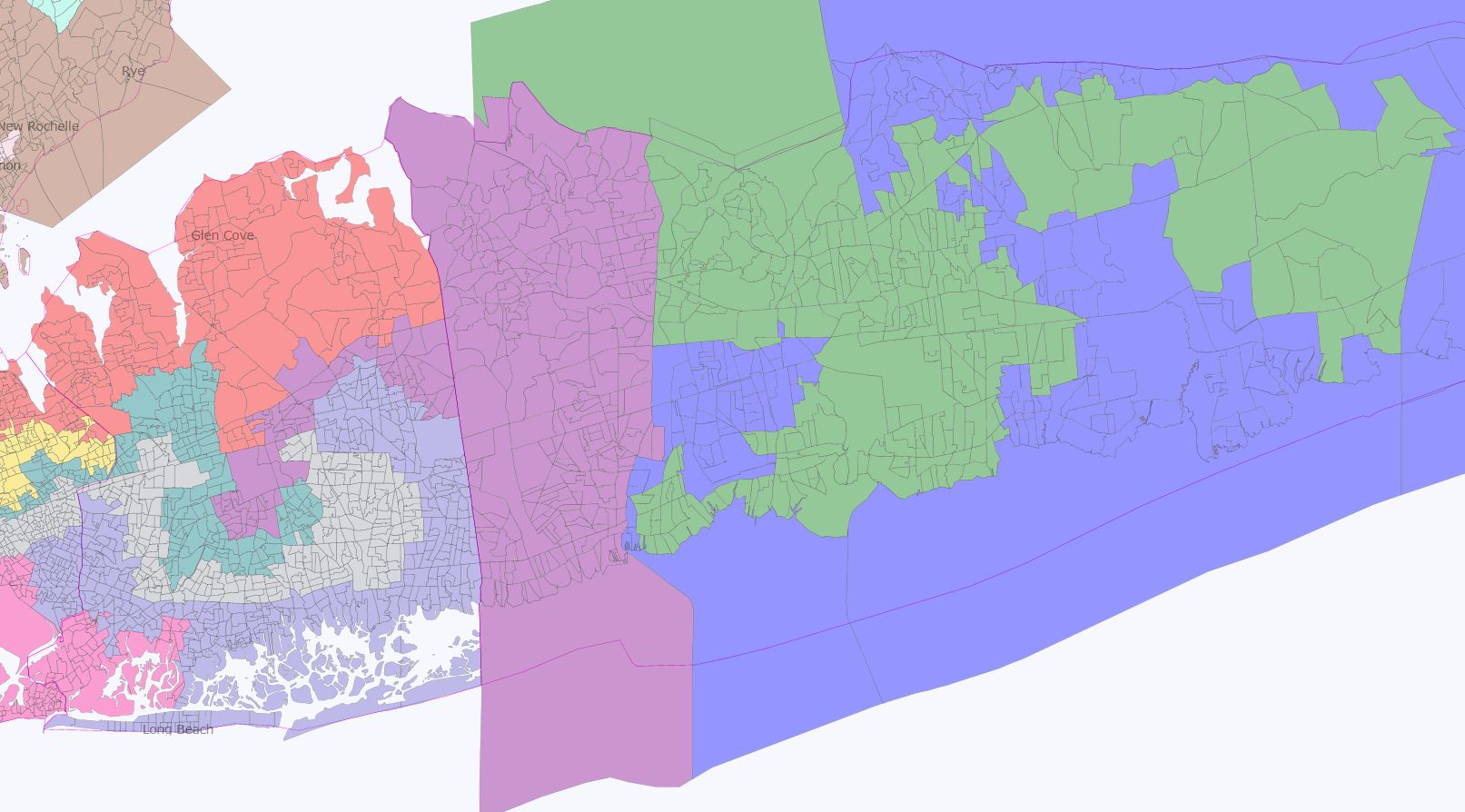
District 1 (Blue) (Bishop (D) if he survives his recount… otherwise it’s his again in 2 years) Obama 59, McCain 40
Lose Republican voting areas in eastern LI and replaces them with Democratic-areas of Islip Town. Turns a swing district into something more like the current NY-02 or NY-04. Bishop should now be fine.
District 2 (Green) OPEN LEAN GOP Obama 46, McCain 54
Realistically this GOP vote sink is necessary to protect Bishop and Israel. I would have drawn Peter King in here but he lives too far away (and as I said, I wanted this map to get rid of that thug of a politician). Would be the only Republican left in the entire downstate New York delegation.
District 3 Israel (D) (Purple) Obama 59, McCain 41
All of Huntington and Babylon towns in Suffolk, finger into Nassau as currently but extends a bit further down to Hempstead and Uniondale to grab black Democratic voters to push the Obama numbers up. Israel should like this district.
Nassau/Queens Hybrid Districts (Districts 4-10)


District 4 (Red) Ackerman Obama, 60, McCain 39
North Shore areas of Nassau that Ackerman represented before in the 1990s, non-Asian areas of northern Queens that are in his district now, and Astoria (a new area for Ackerman but put in the district to bring up the Obama numbers). Helps out the cracking of Peter King by removing parts of his North Shore base. Although the district drops slightly in Democratic performance from now, Ackerman or another Democrat should be fine.
District 5 (Yellow) OPEN ASIAN-INFLUENCE “MINORITY-MAJORITY COALITION” VRA DISTRICT
Obama 69, McCain 30
Asians 39%, Whites 29%, Hispanics 22%, Blacks 6%, Others 4%
If you go to smaller Wyoming-sized districts, you still have to follow the VRA. But ethnic/racial groups that do not have enough numbers to dominate a 720,000-person district do when we’re talking more like 545,000. This was the hardest district to draw because Dave’s redistrict app does not color-code high Asian-American census tracts as it does for Blacks or Hispanics. Luckily, my familiarity with Queens from living in New York City for 6 years helped me somewhat in knowing roughly where Asians reside in Queens.
District 6 (Teal Green) Crowley (D) or Weiner (D) although perhaps Weiner moves back to Brooklyn and runs in my new 14th? Obama 62, McCain 37
Leftover bits of Queens after drawing a new Hispanic VRA district (the 9th), the Asian-influence VRA district (the 5th), and the current black VRA district centered on South Queens (the 8th). It then snakes out in Long Island to continue helping crack Peter King. With a PVI of +9, any generic Democrat should be fine in this district.
District 7 (Gray) McCarthy (D) Obama 61, McCain 38
Dips a bit into Queens to grab excess Blacks not needed for the #10 and helps further crack Peter King by grabbing some redder precincts out of his current district. And it gets 2% more bluer than currently is the case. What’s not to like?
District 8 (Purple-Blue) King (R) Obama 61, McCain 39
I think Peter King is finished with this remap. And where is he going to run if not here?
District 9 (Sky Blue) OPEN VRA HISPANIC DISTRICT
Obama 80, McCain 19
Hispanics 50%, Whites 22%, Asians 14%, Blacks 8%
Barely VRA complaint, but I think it passes legal muster as the nearest demographic group, whites, are 28% less in the district.
District 10 (Pink) Meeks (D) BLACK VRA DISTRICT
Obama 79, McCain 21
Blacks 51%, Whites 26%, Hispanics 16%, Asians 2%
Completes the cracking of GOP voters in Nassau County, and thus Peter King, by sinking the heavily Republican Five Towns and other southwest Nassau GOP areas in a black-majority district that now extends a bit into Brooklyn to equalize its population and gain the necessary blacks to remain VRA complaint. Meeks should still be fine.
Brooklyn (Districts 11-14)

District 11 (neon green) Valasquez (D) HISPANIC VRA DISTRICT Obama 88, McCain 12
Hispanics 51%, Whites 21%, Blacks 13%, Asians 11%
With Wyoming-sized districts, Valasquez’s currently flailing in all directions district gets partitioned into Queens and Brooklyn-only successor districts. There are just enough Hispanics in Brooklyn to make a district and its Valaquez’ for as long as she wants it.
District 12 (light blue) I’m guessing Towns (D)? VRA BLACK DISTRICT
Obama 78, McCain 22
Blacks 52%, Whites 34%, Hispanics 7%
I diluted the black share of this district and Yvette Clarke’s next-door so I could crack heavily McCain precincts in south Brooklyn and keep them away from the open #14. Don’t know for sure whether I kept the Caribbean Blacks in one district and the African-American Blacks in another, though. (This is mainly why the districts are drawn in the weird wrapping-around way right now).
District 13 (beige pink) Yvette Clarke (D)? VRA BLACK DISTRICT
Obama 81, McCain 19
Blacks 52%, Whites 28%, Hispanics 11%, Asians 6%
Also helps crack McCain precincts in south Brooklyn.
District 14 (ugly green) OPEN DEM SEAT Obama 69, McCain 30
Stretches from parts of Williamsburg, Fort Greene, and Park Slope down to Coney Island. I think a Park Slope liberal like David Yassky would love this district; otherwise if Weiner wants to move back to Brooklyn he can have it.
Staten Island-Manhattan Districts (Districts 15-18)
District 15 (orange) Grimm (R) NOT MUCH LONGER!! Obama 67, McCain 32
Takes the last bits leftover in Brooklyn from drawing 4 districts, adds that to about 1/2 of Staten Island, and finishes the job by adding a bit of heavily Democratic lower Manhattan. Shares joint-contiguity across New York Harbor with neighboring 16th with the Staten Island ferry. Thousands of Staten Islanders take that to work each and every day – along with oodles of tourists getting a free view of the Statue of Liberty and Ground Zero. Prior to 1982, the Staten Island district connected with a bit of Manhattan. It’s perfectly legal.
District 16 (green) Nadler (D) Obama 69, McCain 31
Nadler helps complete the job of cracking Staten Island. Even better his type of progressive politics causing Staten Islanders even bigger heartburn. Want to secede from NYC? Tough, you can’t!

District 17 (dark purple) Maloney (D) Obama 78, McCain 21
Shrinks to become just an East-Side Manhattan district, like it was before the 1990s.
District 18 (yellow) Rangel (D) VRA “MINORITY-MAJORITY COALITION DISTRICT”
Obama 94, McCain 5
Hispanics 45%, Blacks 37%, Whites 13%
Largely the same as before, without Rikers Island or a bit of upper-most Manhattan. Due to the exponential growth of Dominicans, it is no longer possible to draw a black-majority district in Harlem anymore without crossing over into the Bronx.
Bronx-Lower Westchester Districts (Districts 19-21)
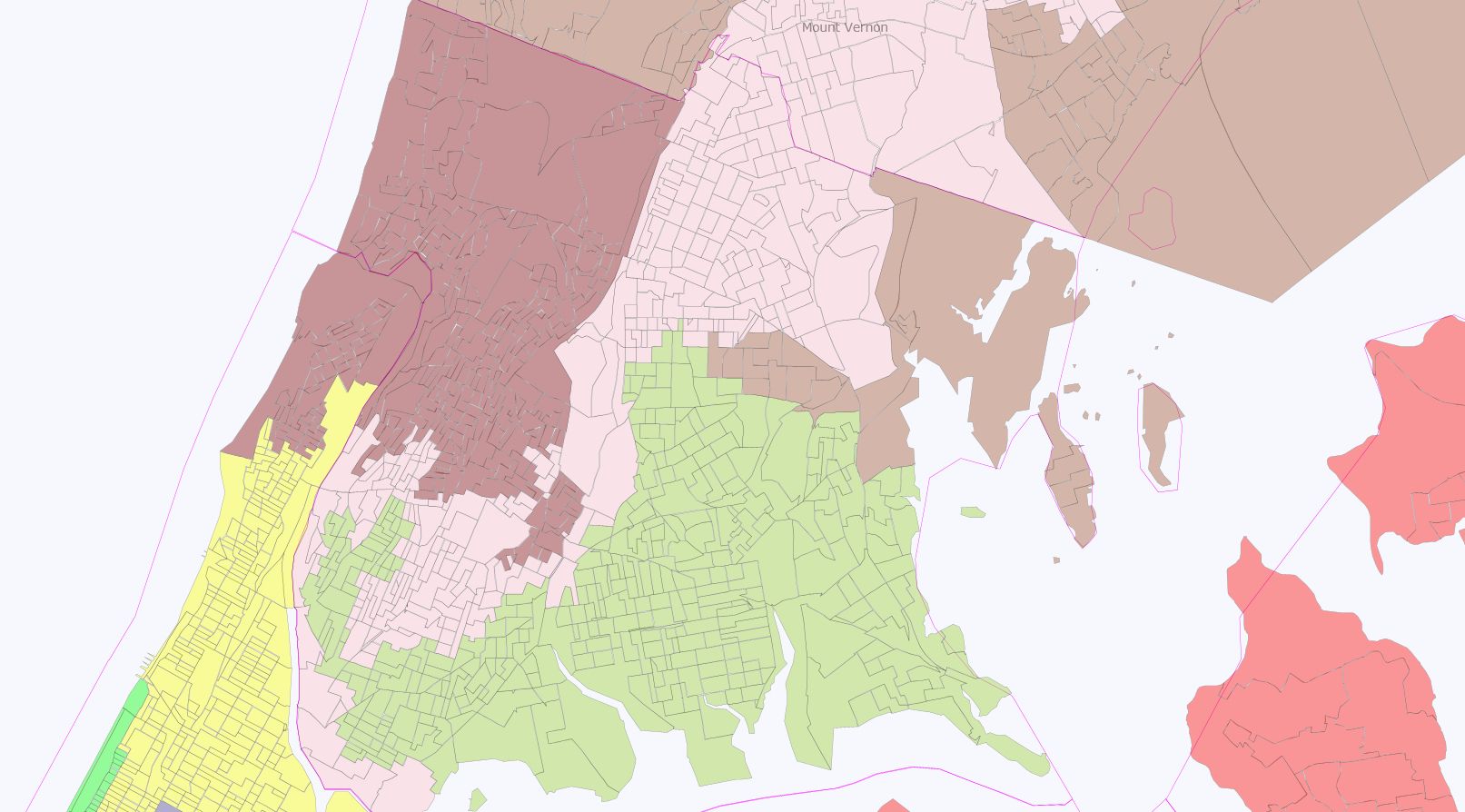
District 19 (Serrano (D) VRA HISPANIC DISTRICT
Obama 85, McCain 14
Hispanics 54%, Blacks 23%, Whites 17%
Did a bit of rejiggering of the Bronx districts to create a second Hispanic VRA district as well as an African-American one. But Serrano should be fine.
District 20 OPEN VRA BLACK DISTRICT
Obama 89, McCain 11
Blacks 51%, Hispanics 31%, Whites 14%
One of the best outcomes in my mind of a Wyoming Rule is that it enables you to craft VRA complaint districts in areas that you ordinarily cannot now. Such is the case of northern Bronx/Mount Vernon. District extends a bit north to Eastchester Town in Westchester to steal GOP votes from Lowey’s district.
District 21 (maroon) Engel (D) but likely not for much longer VRA HISPANIC DISTRICT
Obama 87, McCain 12
Hispanics 58%, Whites 18%, Blacks 17%
Under the Wyoming Rule and the VRA, Bronx is going to have to have a second Hispanic district. And with that, Engel loses a seat, unless he wishes to move to Rockland County and take on the open swing district there. Not that I care much; I find Engel one of the least effective congressmen from the New York delegation.
Lower-Mid Hudson Valley (Districts 22-25)
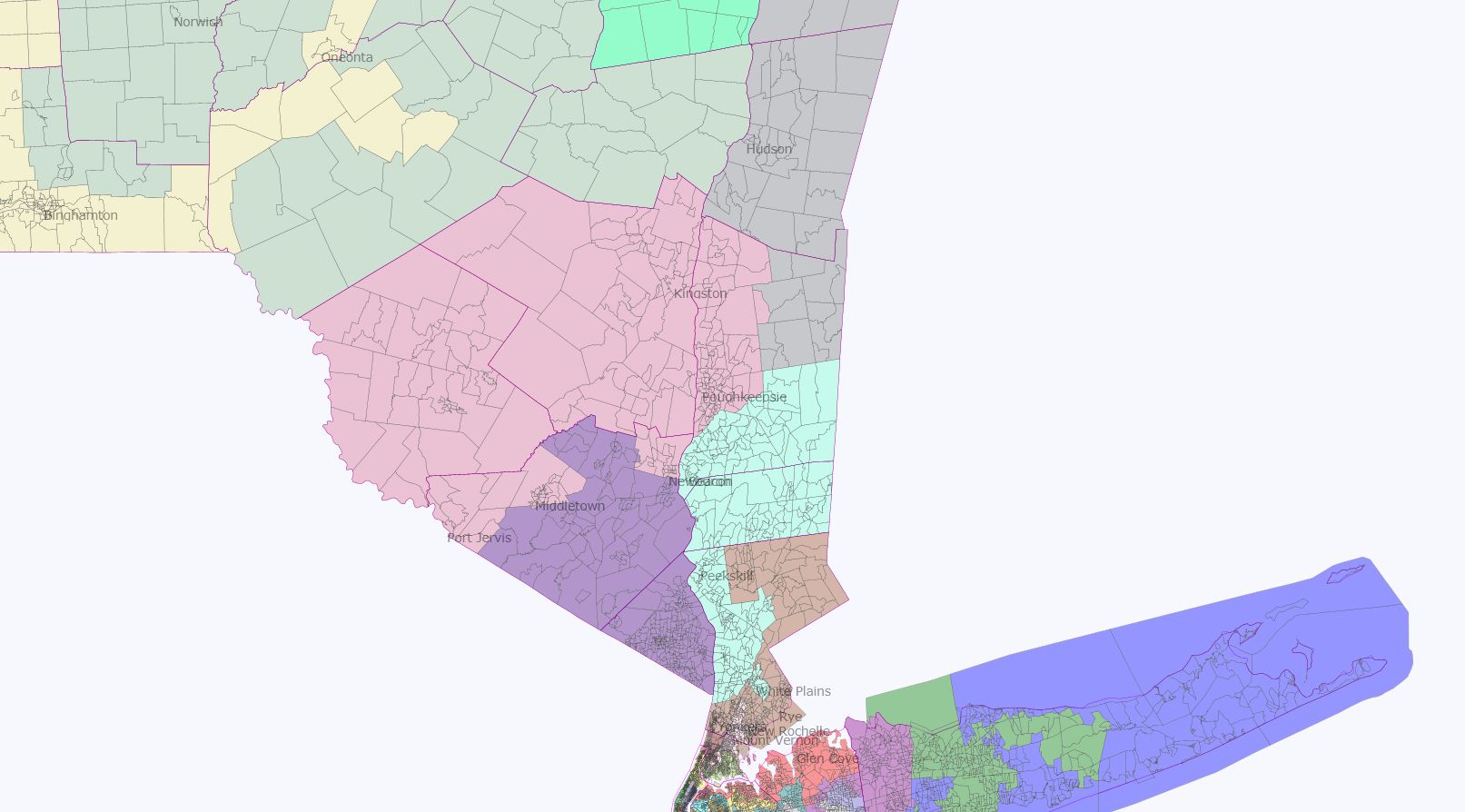
District 22 (brown) Lowey (D) Obama 60, McCain 39
Most of Westchester, goes north to grab a few more Republican-leaning areas away from Hayworth in the 23rd and helps transform that district from a swing district into a lean-Democratic one now. Lowey, who’s an institution in Westchester, should be fine.
District 23 (very light blue) Hayworth (R) but not for much longer!
Obama 58, McCain 42
This would be my home district were I still living where I grew up. Ancestrally Republican, southern Dutchess is now becoming a swing region, in part due to people moving in from New York City and Westchester, but also in part due to the Republican party lurching right off of a cliff over the past 2 decades. The type of Republicans this region used to support were centrists like long-serving GOP congressman Ham Fish Jr., current State Senator Steve Saland who isn’t all that bad especially on education issues, and George Pataki who is bad on education issues but pretended to be a socially liberal Republican while governor between 1995 and 2007.
Still, by going deep into Democratic areas of Westchester, it is possible to draw this district so that it has a Democratic PVI. John Hall probably would have won reelection on these lines.
District 24 (purple) OPEN SWING DISTRICT/LEAN GOP?
Obama 51, McCain 49
Welcome to a reincarnated version of the old Ben Gilman district. Going by Obama percentages alone would suggest that this is a lean-GOP district. However, for some reason or another, Obama didn’t sit well with a lot of Jewish Rockland and southern Orange voters; similarly, he didn’t earn the robust vote percentages out of Long Island that Clinton and Gore received. Perhaps a lingering 9-11 effect? Well, whatever the reason, Rockland and southern Orange are heavily Jewish regions that tend to support Democrats at the state and local level. A Republican can win here but it has to be a Republican in the mold of Ben Gilman, who even when he was serving in congress (1972-2002) was considered a RINO. I like our chances in this district even though I drew it this way to maximize the Democratic chances in the 23rd and the 25th next door.
District 25 (pink) Hinchey (D) Obama 59, McCain 40
Hinchey finally gets a Catskills-Hudson Valley only district instead of his squiggling around all over the place! I love the Wyoming Rule!!
Central New York-Capital Region
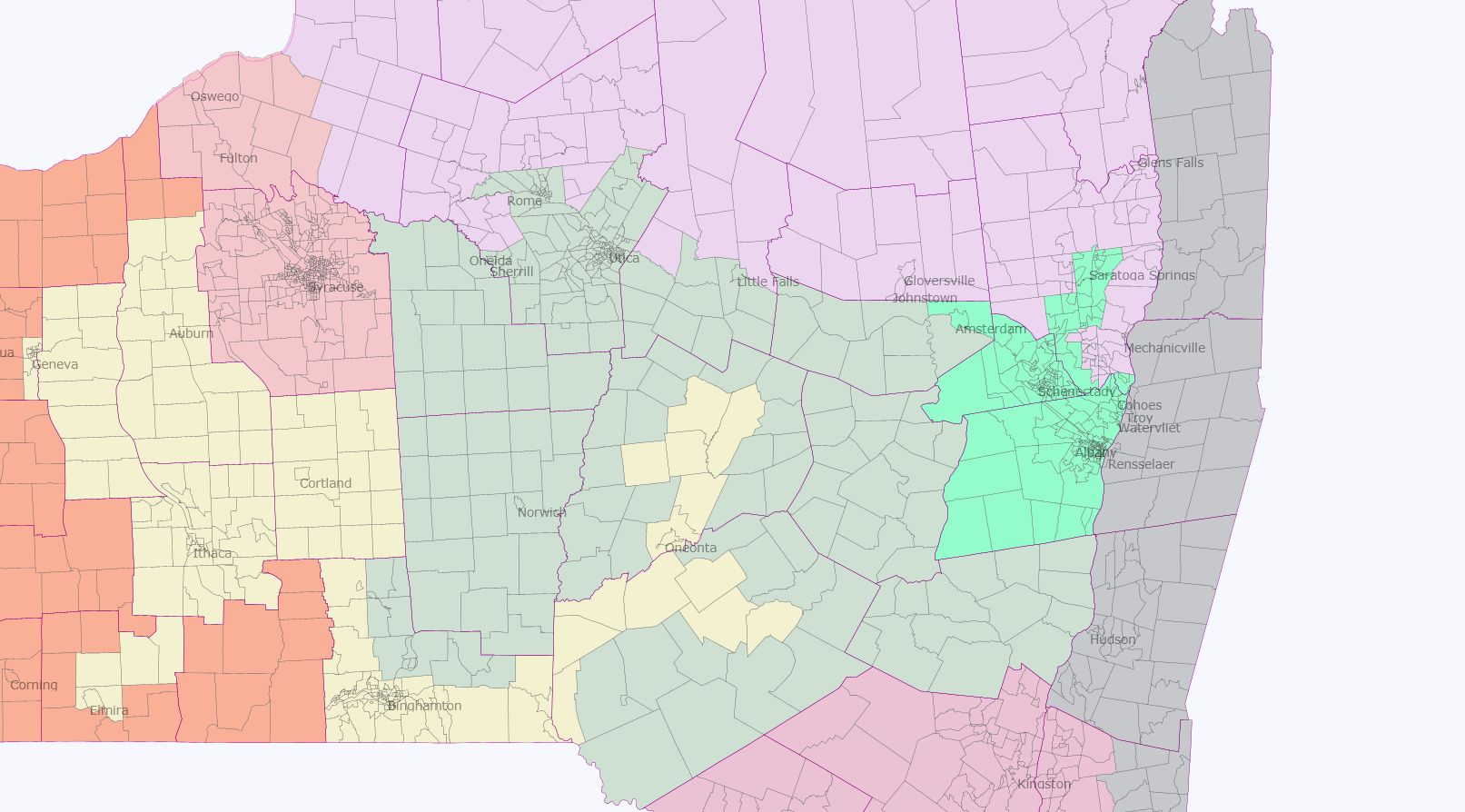
District 26 (grey) Gibson (R) vs. Owens (D) LEAN DEMOCRATIC Obama 56, McCain 42
Being purely tactical here, I combined the most Democratic areas of both the current 20th and the 23rd, excising out the most Republican regions of each (Jefferson, Lewis, northern Oneida, Hamilton, Fulton, etc. in the 23rd; Saratoga in the current 20th). While I do not like blue Dog DINO Owens, he has shown moxy in winning not once but twice a district that never elected a Democrat before in something like a century. Now he has a district that has a lean-Democratic PVI… and without having to cut Albany in half.
District 27 (neon green) Tonka (D) Obama 60, McCain 39
The Albany outlaying region is slowly turning against national Democrats. Decided here to shore up Tonka a little by grabbing Saratoga Springs. The neighboring 28th is one of 4 GOP vote sinks in upstate New York so this makes a bit of sense.
District 28 (lilac) OPEN GOP SEAT Hoffman probably? (Ugh!) Obama 47, McCain 52
The consequence of making a safer district for Bill Owens is that we probably also get Doug Hoffman. Oh well….
District 29 (green/gray) Hanna (R) Obama 47, McCain 51
A lean-GOP vote sink in upstate New York because frankly Oneida County has too many frigging Republicans and because under the Wyoming Rule, there’s no place really for them to go but here. also, I wanted to a safer district for Maffei near Syracuse and an open Democratic college-towns district near the Binghamton-Ithaca area. So, Hanna gets a safish district. Arcuri could make a comeback, though, as it isn’t all that Republican.
District 30 (light red) Maffei? (D) Obama 58, McCain 40
I think Dan Maffei is well primed for a comeback with these lines. Includes along with all of Syracuse-dominating Onondaga County, most of Oswego, including the university town that is bound to turn out big for President Obama in 2012.
District 31 (cream) OPEN DEMOCRAT SEAT
Obama 57, McCain 41
I had a lot of fun creating this one. In addition to grabbing pockets of Democratic voters from Central New York, the Southern Tier, and the Finger Lakes, it is a community of interest district: it is a universities and colleges district. SUNY-Oneonta, Hartwicke College, SUNY-Binghamton (my alma mater), Ithaca College, Cornell University, SUNY-Cortland, the list goes on and on. And I think a liberal/progressive in the mold of Maurice Hinchey would do just fine here.
District 32 (red-orange) Tom Reed (R) Obama 43, McCain 56
This is the most Republican district in New York, and serves as one of four GOP vote sinks in Upstate to ensure the election of 7 Democrats in neighboring districts. Worth the trade in my opinion. Takes most of the Republican areas of the Southern Tier and connects them via a narrow corridor in Ontario County to uber-GOP Wayne County (the reason why Maffei lost btw).
Rochester-area
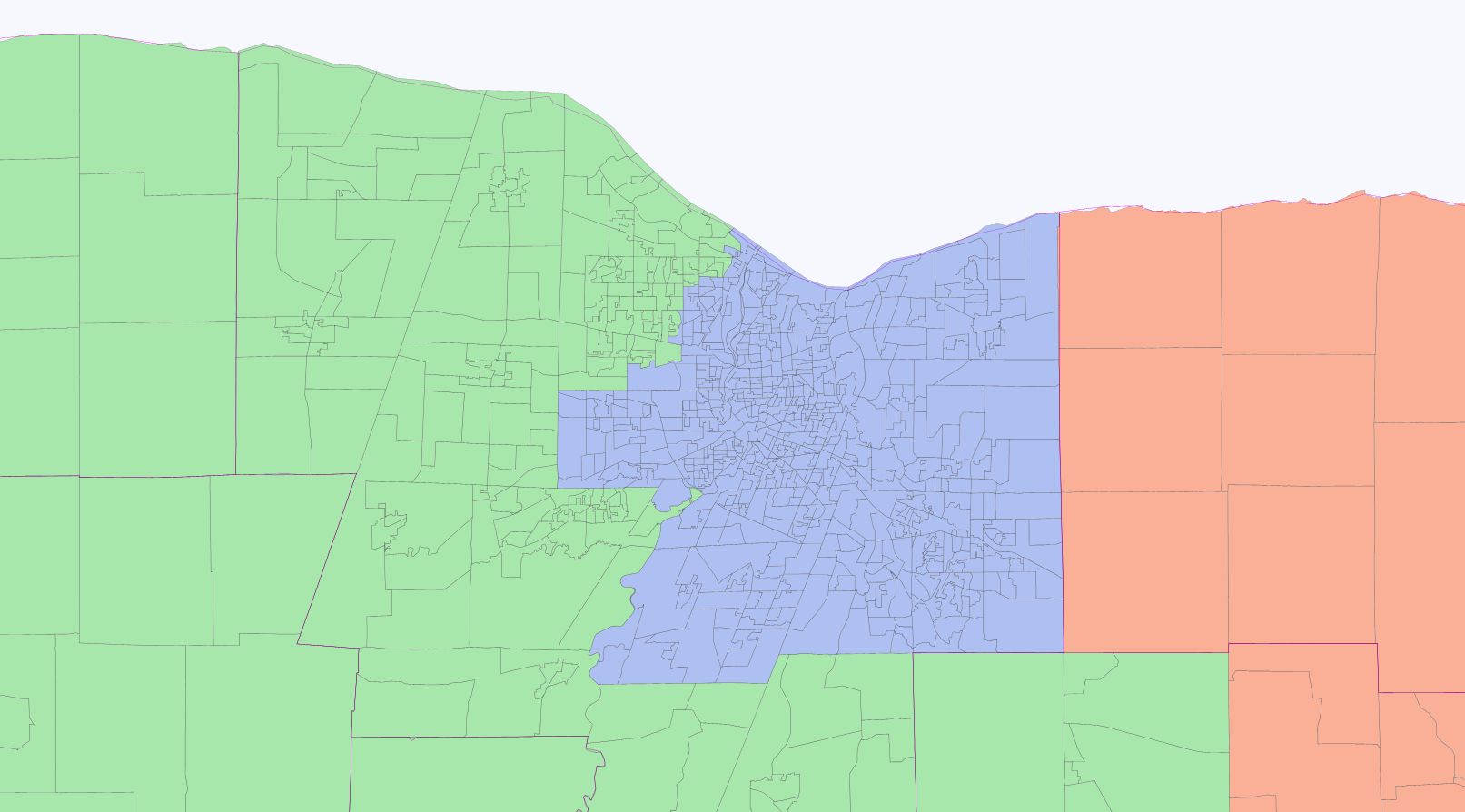
District 33 (blue) Slaughter (D) Obama 63, McCain 36
Could have risked it and created another Democratic district in Western New York other than the 3 I have created there. But let’s face it; Slaughter is getting on in years, the suburbs of Monroe County aren’t nearly as blue as those of Erie, and it just ain’t worth it when you already are running up the score downstate where there are more reliably Democratic votes to unpack. This district therefore consists of the entire city of Rochester and its immediate suburbs, safely Democratic even when Slaughter decides to retire.
Buffalo-area
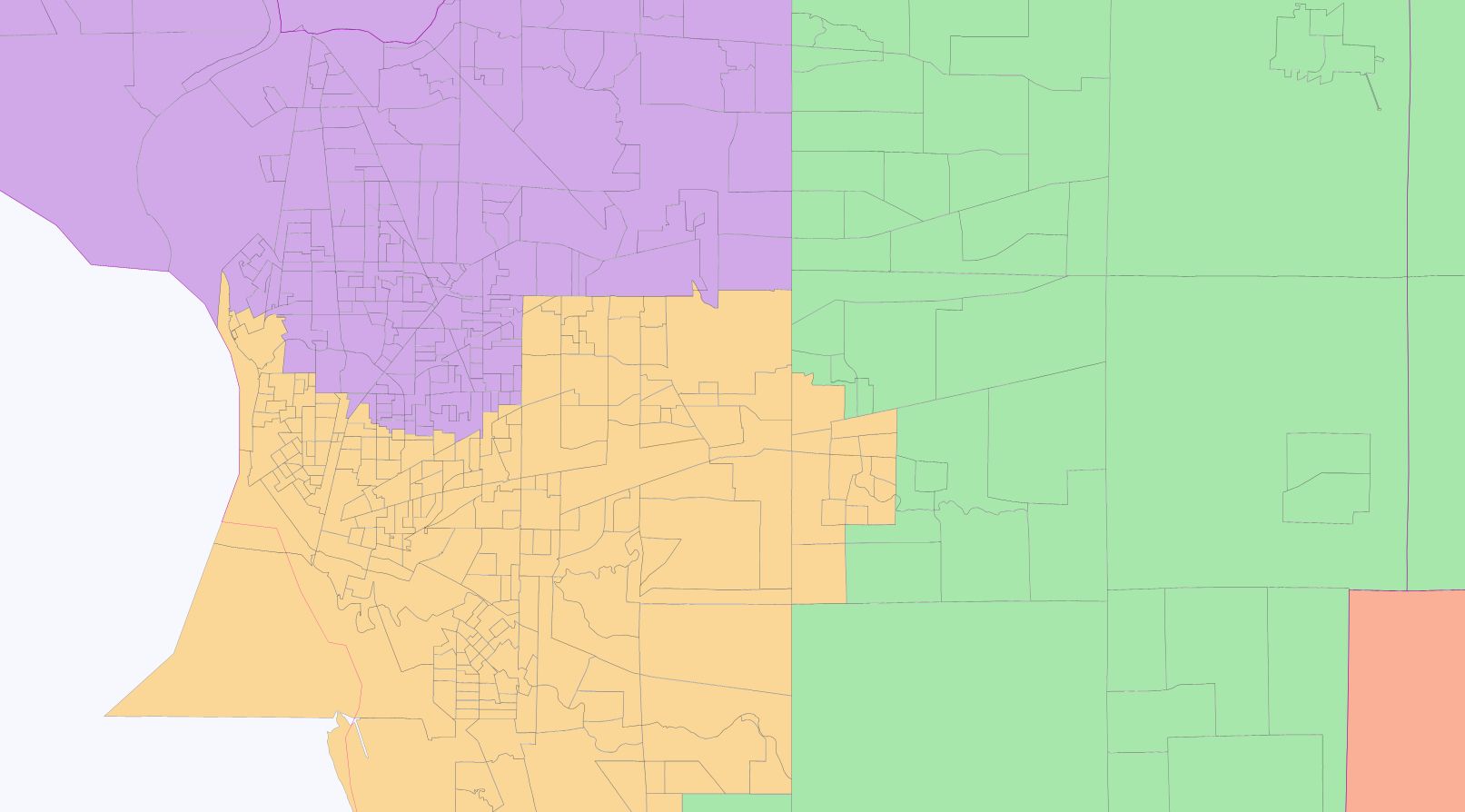
District 34 (green) Lee (R) Obama 44, McCain 54
Republican suburbs of Erie County, the heavily GOP GLOW region between Rochester and Buffalo, and parts of Ontario County left over from the 32d. A safe GOP district for as long as Lee wants it, designed this way to ensure a Democratic victory in the neighboring 35th and 36th seats.
District 35 (purple) OPEN DEMOCRATIC SEAT
Obama 58, McCain 40
A reincarnation of the old LaFalce seat, without its little finger into Rochester. A generic Democrat should do just fine here.
District 36 (orange) Huggins (D) Obama 58, McCain 40
Little changed from current district in being a Erie-Chautauqua hybrid, but gains bluer portions of Buffalo to raise its Democratic performance a bit. Remember in 2002, the district was drawn to be a district that a Republican, namely Jack Quinn, could win.















































